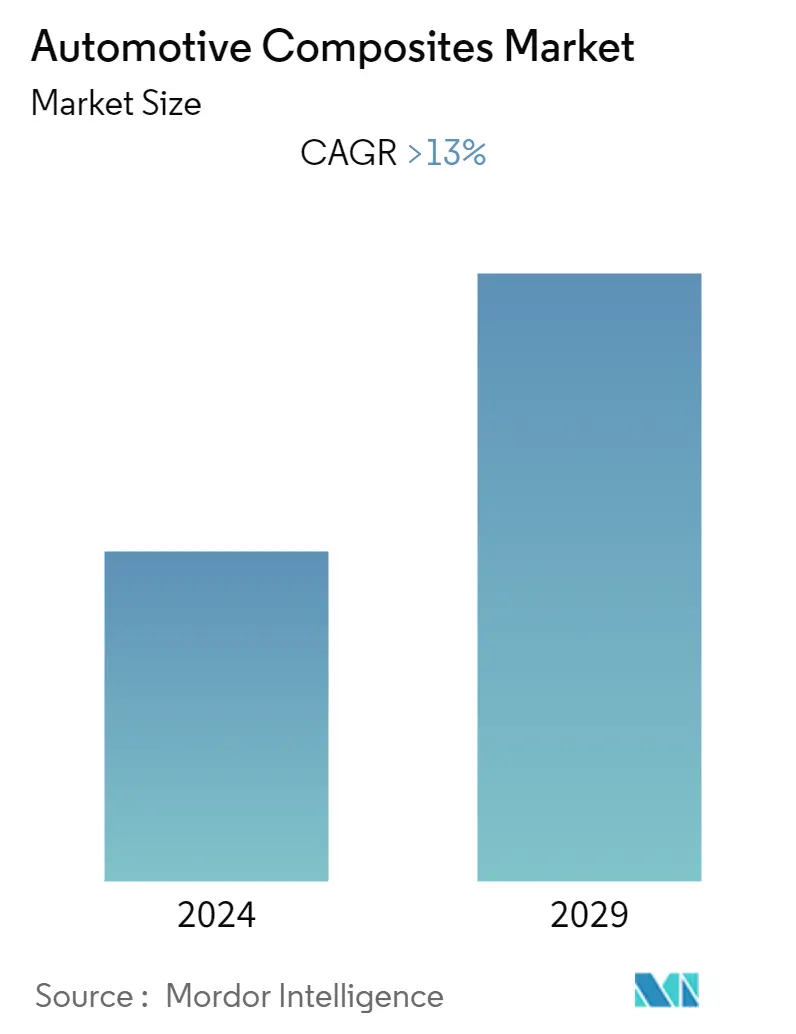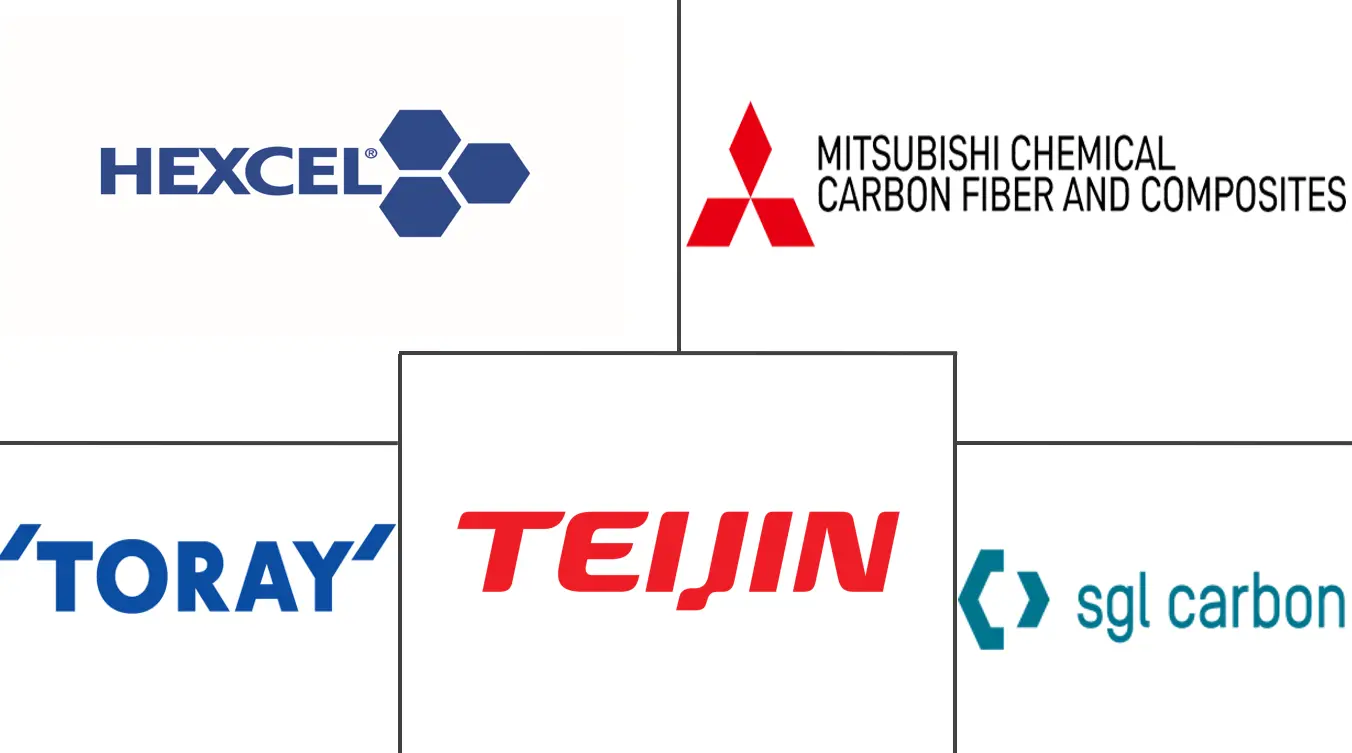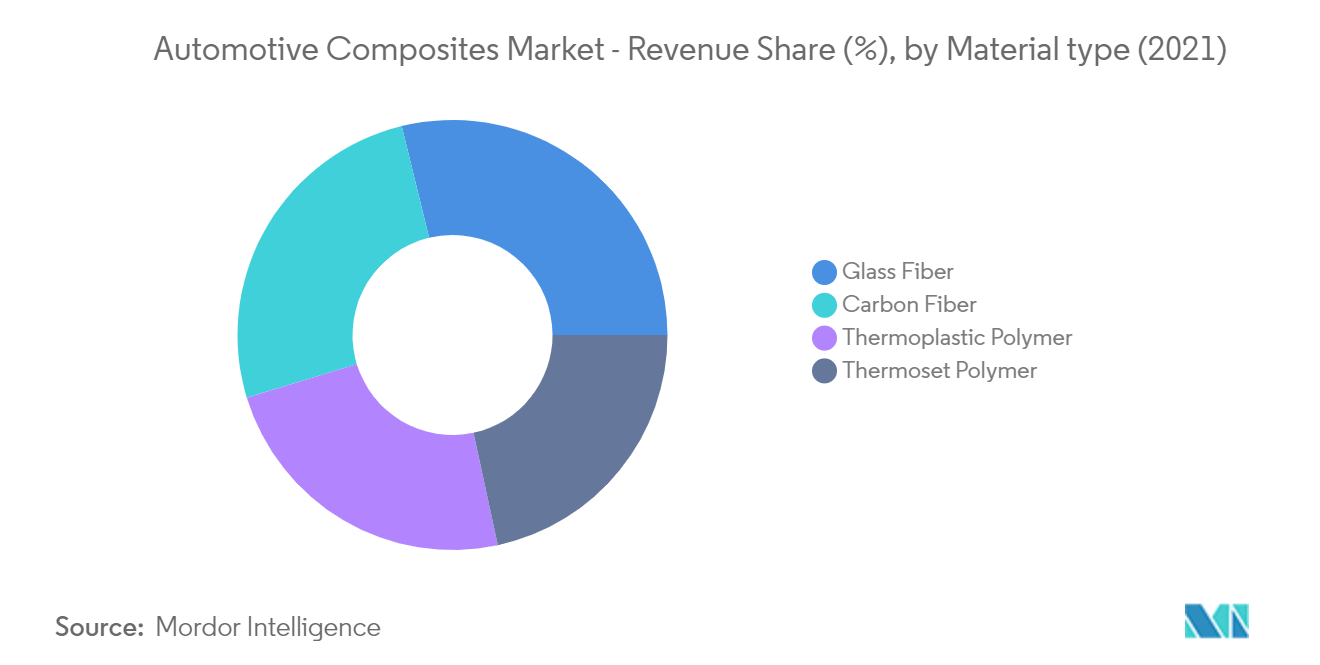Automotive Composites Market Size

| Study Period | 2019 - 2029 |
| Base Year For Estimation | 2023 |
| CAGR | 13.00 % |
| Fastest Growing Market | Europe |
| Largest Market | Asia Pacific |
| Market Concentration | Medium |
Major Players
*Disclaimer: Major Players sorted in no particular order |
Automotive Composites Market Analysis
The automotive composites market was valued at USD 27.12 billion in 2021 and is expected to reach USD 56.46 billion by 2027, registering a CAGR of over 13% during the forecast period 2022 - 2027.
Over the short term, the COVID-19 pandemic has had a negative impact on the market. With stringent lockdown and social distancing norms implemented across the world, the production of composite materials was severely affected. With the reduced number of vehicle sales worldwide, the market opportunity for composites to be used as different structures in vehicles was completely reduced.
Over the long term, Factors such as increasing demand for lightweight materials from the automotive industry and a growing focus on fuel economy are expected to be major drivers for the market. However, the high cost associated with carbon fiber composites and glass fiber composites is hindering the growth of the market. Usage of such composites in low-cost vehicles could increase the prices of such vehicles drastically.
The low recyclability of composites is also a restraint for their penetration in entry-level passenger vehicles. However, collaborations of the OEMs with suppliers (due to rising demand for fuel-efficient vehicles, growing lightweight electrical vehicle segment, and major automobile giants, like BMW and Nissan, trying to replace their existing metal parts with composite fibers) imply the scope and booming opportunity that the market is anticipated to offer over the forecast period.
Presently, composite materials, like thermoplastics and reinforced glass, have drawn the attention of carmakers, making them focus on sourcing better, tensile, and lighter components to manufacture automobile units.
Automotive Composites Market Trends
This section covers the major market trends shaping the Automotive Composites Market according to our research experts:
Growing Demand for Lightweight Materials
The automotive industry has been focusing on the weight of vehicles as it has a direct impact on driving dynamics and fuel consumption. Due to the high cost of potential lightweight solutions and consumers' limited willingness to pay for weight reduction in automotive, the use of costly lightweight materials has so far been limited.
As governments worldwide are implementing stringent emission regulations and planning to set even higher emissions standards in the coming years, the importance of lightweight materials will likely increase. In a typical automobile, fiber is 50% by volume, while adding just 10% to the weight. In the United States, regulations mandate that by 2025, the average fuel economy standard must meet 54.5 miles per gallon.
A mileage-sensitive market like India is a great market for composites, owing to the demand for better fuel efficiency from vehicles, which can be achieved by using different composites. Although composites can account for a great business in the country, the costs associated with the research and development of the composites in vehicles can be a restraint for the market.
With the demand for lightweight vehicles increasing rapidly in developing economies, the market for carbon fiber composites is projected to grow at a fast pace during the forecast period.

Asia-Pacific leading the Automotive Composite Market
The automotive composites market is led by Asia-Pacific, followed by Europe and North America, in that order. The demand for lightweight materials is growing rapidly in the region due to the growing automotive industry and emission regulations.
- For instance, in India, the automotive industry is expanding rapidly, with the rising income level of consumers. In addition, the demand for lighter vehicles has increased with awareness about fuel efficiency and environmental benefits.
- Currently, India is the fifth-largest producer of light and commercial vehicles and is the second-largest producer of two-wheeler vehicles. With the rapid growth in manufacturing capacities in the country, the consumption of carbon fiber composites is expected to increase during the forecast period.
Emission legislation regulations in the United States and Europe have forced automobile manufacturers to restrict the exhaust levels of their vehicles. Vehicles in the European region have started to adapt to Euro 6 norms, while other regions have also followed suit. The higher standards (which are for controlling the emissions) are, in turn, dependent on the vehicle's weight, combustion, and fuel efficiency and thus are difficult to achieve.
Demand for customized cars is on the rise globally, with the younger population showing a keen interest in customizing their cars like sports and racing cars. In the manufacture of racing cars and luxury sports cars, thermoset composites have already been widely in use for many years. Together, these factors are expected to drive the market for automobile composites toward exponential growth in the future.

Automotive Composites Industry Overview
Companies, such as Toho Tenex (Teijin Ltd), Toray Industries Inc, Mitsubishi Chemical Carbon Fiber and Composites, Inc., and SGL Carbon, are some of the major players in the market studied. Companies are trying to invent new composites that can reduce the vehicle's total weight to much lower proportions. For instance,
- In June 2021, Mitsubishi Chemical Co., Ltd. announced the development of a new carbon fiber prepreg that can be used as a part of an automotive engine.
- In March 2021, Hexcel joined ASCEND Project, aiming to improve high-rate manufacturing and processing technologies to develop lightweight advanced composite materials for the automotive and aerospace industry.
BMW has adopted carbon fiber reinforced plastic in a mixed-material approach. Its German competitor, Audi, is also using the material to produce the rear wall of the space frame for its A8 luxury sedan. This part provides around 40% of the vehicle's overall torsional rigidity, making it suitable for manufacture with CFRP. The part is around 50% lighter in weight than its metallic predecessor.
Automotive Composites Market Leaders
-
Hexcel Corporation
-
Mitsubishi Chemical Carbon Fiber and Composites, Inc.
-
SGL Carbon
-
Toray Industries Inc
-
Teijin Ltd
*Disclaimer: Major Players sorted in no particular order

Automotive Composites Market News
- In April 2021, Solvay introduces Amodel® Supreme PPA, a new line of high-performance polyphthalamide (PPA) compounds designed for demanding e-mobility and metal replacement applications. Amodel® Supreme PPA brings a higher level of performance to systems requiring exceptional thermal, mechanical, and electrical properties. Applications range from high-temperature automotive components used in electric drive units including e-motors, power electronics, housings for high-temperature electrical connectors, electric and electronic devices, and telecommunication equipment components that need excellent heat resistance.
- In February 2021, Hexcel Corporation collaborating with NaCa Systems, a supplier of natural fiber composite automotive interior parts, is developing a lightweight carbon fiber prepreg and wood fiber composite sports car seat back using a rapid press molding process. This innovation validates a short-cycle time production process for CFRP and wood fiber composite parts and offers a host of benefits to automotive manufacturers.
- In September 2020, Sigmatex, announced the launch of a recycled carbon fibre non-woven fabric. This non-woven fabric is produced from high quality carbon fibre waste, with sizing intact, offering improved fibre to resin bond strength with area weights from 100gsm to 600gsm. The highly conformable product is an isotropic material with excellent mechanical properties that can be debulked, improving processing via pre-preg methods.
- In September 2020, Mitsubishi Chemical Advanced Materials, Inc. announced its strategic alliance with R3 Composites Corp. supplier in compression molded thermoset products to combine both company's expertise to offer comprehensive solutions to customers in North America. The alliance will centre around the design, development and production of advanced carbon-based composites, including mobility applications.
- In August 2020, SGL Carbon received a multi-year order from Koller Kunststofftechnik GmbH for the production of novel carbon fibre profiles for serial use in windshields for a future high-volume model of BMW Group. The profiles are particularly flexible fibre tows, pre-impregnated with thermoplastic resin in various dimensions.
- In February 2020, SGL Carbon announced that it will present the new composite battery enclosure, which is driven by the need for flexible chassis platforms. The battery enclosure is based on carbon fiber; in addition, the company also revealed its leaf spring made of glass fiber composite.
Automotive Composites Market Report - Table of Contents
1. INTRODUCTION
- 1.1 Study Assumptions
- 1.2 Scope of the Study
2. RESEARCH METHODOLOGY
3. EXECUTIVE SUMMARY
4. MARKET DYNAMICS
- 4.1 Market Driver
- 4.2 Market Restraint
-
4.3 Industry Attractiveness - Porter's Five Forces Analysis
- 4.3.1 Threat of New Entrants
- 4.3.2 Bargaining Power of Buyers/Consumers
- 4.3.3 Bargaining Power of Suppliers
- 4.3.4 Threat of Substitute Products
- 4.3.5 Intensity of Competitive Rivalry
5. MARKET SEGMENTATION
-
5.1 Application
- 5.1.1 Structural Assembly
- 5.1.2 Powertrain Component
- 5.1.3 Interior
- 5.1.4 Exterior
-
5.2 Material
- 5.2.1 Thermoset Polymer
- 5.2.2 Thermoplastic Polymer
- 5.2.3 Carbon Fiber
- 5.2.4 Glass Fiber
-
5.3 Geography
- 5.3.1 North America
- 5.3.1.1 United States
- 5.3.1.2 Canada
- 5.3.1.3 Rest of North America
- 5.3.2 Europe
- 5.3.2.1 Germany
- 5.3.2.2 United Kingdom
- 5.3.2.3 France
- 5.3.2.4 Italy
- 5.3.2.5 Rest of Europe
- 5.3.3 Asia-Pacific
- 5.3.3.1 China
- 5.3.3.2 Japan
- 5.3.3.3 India
- 5.3.3.4 South Korea
- 5.3.3.5 Rest of Asia-Pacific
- 5.3.4 Rest of the World
- 5.3.4.1 South America
- 5.3.4.2 Middle-East and Africa
6. COMPETITIVE LANDSCAPE
- 6.1 Vendor Market Share
-
6.2 Company Profiles*
- 6.2.1 Hexcel Corporation
- 6.2.2 Mitsubishi Chemical Carbon Fiber and Composites, Inc.
- 6.2.3 mouldCAM Pty Ltd.
- 6.2.4 SGL Carbon
- 6.2.5 Toho Tenex (Teijin Ltd)
- 6.2.6 Toray Industries Inc
- 6.2.7 Nippon Sheet Glass Company, Limited
- 6.2.8 Sigmatex
- 6.2.9 Nippon Carbon Co., Ltd.
- 6.2.10 Solvay
7. MARKET OPPORTUNITIES AND FUTURE TRENDS
** Subject To AvailablityAutomotive Composites Industry Segmentation
Composites are being considered to make lighter, safer and more fuel-efficient vehicles. A composite is composed of a high-performance fiber (such as carbon or glass) in a matrix material (epoxy polymer) that when combined provides enhanced properties compared with the individual materials by themselves.
The automotive composites market is segmented by application type, by material type, and by geography.
By application type, the market is segmented as Structural Assembly, Powertrain Component, Interior, and Exterior. By Material Type, the market is segmented as Thermoset Polymer, Thermoplastic Polymer, Carbon Fiber, And Glass Fiber. By Geography, the market is segmented as North America, Europe, Asia-Pacific, and the Rest of the World.
| Application | Structural Assembly | |
| Powertrain Component | ||
| Interior | ||
| Exterior | ||
| Material | Thermoset Polymer | |
| Thermoplastic Polymer | ||
| Carbon Fiber | ||
| Glass Fiber | ||
| Geography | North America | United States |
| Canada | ||
| Rest of North America | ||
| Geography | Europe | Germany |
| United Kingdom | ||
| France | ||
| Italy | ||
| Rest of Europe | ||
| Geography | Asia-Pacific | China |
| Japan | ||
| India | ||
| South Korea | ||
| Rest of Asia-Pacific | ||
| Geography | Rest of the World | South America |
| Middle-East and Africa |
Automotive Composites Market Research FAQs
What is the current Automotive Composites Market size?
The Automotive Composites Market is projected to register a CAGR of greater than 13% during the forecast period (2024-2029)
Who are the key players in Automotive Composites Market?
Hexcel Corporation, Mitsubishi Chemical Carbon Fiber and Composites, Inc., SGL Carbon, Toray Industries Inc and Teijin Ltd are the major companies operating in the Automotive Composites Market.
Which is the fastest growing region in Automotive Composites Market?
Europe is estimated to grow at the highest CAGR over the forecast period (2024-2029).
Which region has the biggest share in Automotive Composites Market?
In 2024, the Asia Pacific accounts for the largest market share in Automotive Composites Market.
What years does this Automotive Composites Market cover?
The report covers the Automotive Composites Market historical market size for years: 2019, 2020, 2021, 2022 and 2023. The report also forecasts the Automotive Composites Market size for years: 2024, 2025, 2026, 2027, 2028 and 2029.
Automotive Composites Industry Report
Statistics for the 2024 Automotive Composites market share, size and revenue growth rate, created by Mordor Intelligence™ Industry Reports. Automotive Composites analysis includes a market forecast outlook to 2029 and historical overview. Get a sample of this industry analysis as a free report PDF download.



